|
|
|
Sort Order |
|
|
|
Items / Page
|
|
|
|
|
|
|
| Srl | Item |
| 1 |
ID:
115818
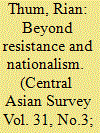

|
|
|
|
|
| Publication |
2012.
|
| Summary/Abstract |
Kashgar's seventeenth-century ruler-saint, Afaq Khoja, is remarkable for the amount of historical writing he has inspired, both outside and within Chinese Turkestan. His reputation among Uyghur historians is one of the few aspects of local Uyghur historical knowledge production that has attracted the attention of foreign scholars. In this essay the author uses the now-familiar example of Afaq Khoja's reputation to show that much of what is distinctive about local Uyghur approaches to history has been so little understood as to be missed even in this often-discussed case. This article describes how the local historical appropriation of Afaq's reputation, particularly the recording of narratives about Afaq in writing, began as a typical product of the Naqshbandi maqamat tradition, was reshaped into Kashgarian local history in the nineteenth and early twentieth centuries, and then reshaped again as an ethno-national history beginning in the 1930s, culminating in the publication of the popular historical novel, Apaq Khoja, and its subsequent burning by officials of the People's Republic of China. While the reputation of Afaq in the present certainly reflects the current political context, it also bears significant marks of these earlier traditions through which it has passed. Thus this article argues for an understanding of 'local history' as a form of knowledge production that embraces a host of historical approaches, including transnational devotional literature, popular local oasis history and nationalist historical fiction. The author also suggests that these transformations of local history have reflected shifting senses of what is 'local' over the last 300 years. The argument is advanced through philological investigation of the manuscript sources, ethnographic fieldwork and literary analysis of the recent novel Apaq Khoja.
|
|
|
|
|
|
|
|
|
|
|
|
|
|
|
|
| 2 |
ID:
115816
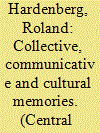

|
|
|
|
|
| Publication |
2012.
|
| Summary/Abstract |
In recent years several historical publications have appeared in Kyrgyzstan which are far from homogeneous in terms of style, form and content. In this article, two very different local histories written by Kyrgyz authors from the same village are analysed and compared. The first author is a former kolkhoz president who produced two books that basically cover the time from the end of the nineteenth to the end of the twentieth century. His work is strongly (auto)biographical and focuses on individual achievements and personal experiences. The second author is a mathematician who wrote two books about the history of his own descent category (uruu). His work combines oral history (sanjyra) with written sources. The two authors create very different images of 'esteemed people' (ardaktuu adamdar), yet they exhibit a common interest in producing a narrative that links the deeds of one's own people (family or descent group) with the history of particular places (pastures, villages or regions). Taking up these observations, the author argues that local histories relate to different types of memory and are far from uniform with regard to their composition, sources, methods and narrative strategies. Yet, despite their diversity, the newly developed genres of 'written collective memory' provide the idea of social continuity by stressing connections between past and present, and between people, land and morality. This may indeed be one reason why collective memories, which were suppressed for many decades, have become so popular in times of rapid social transformation.
|
|
|
|
|
|
|
|
|
|
|
|
|
|
|
|
| 3 |
ID:
115821


|
|
|
|
|
| Publication |
2012.
|
| Summary/Abstract |
This article examines the changing relationship between ethno-national and local narratives in the historiography of Kazakhstan's Uyghurs through the parallel analysis of general and local histories compiled in the Soviet and post-Soviet periods. Uyghur history writing in the post-Soviet period is discussed in relation to the divided loyalty of the Uyghur community: while interest in writing ethno-nationalist histories is based on the growing feeling of being a part of the broad, transnational category of the Uyghur, deep attachment to the Semirech'e region is expressed in the emerging histories of Uyghur villages and neighbourhoods. In analysing the local histories of Kazakhstani Uyghurs in the post-Soviet period, the author focuses on the gradual transition from Soviet-style local histories praising the uniqueness of the 'Soviet' Uyghurs to new local histories emerging 'from below' as exemplified by the history of the Sultanqorghan neighbourhood of Almaty.
|
|
|
|
|
|
|
|
|
|
|
|
|
|
|
|
| 4 |
ID:
115819


|
|
|
|
|
| Publication |
2012.
|
| Summary/Abstract |
Focusing on representations of the Muslim dynasty that exercised power locally under the Qing dynasty until 1930 in the oasis of Qumul in eastern Xinjiang, this article challenges the binary notions of 'official' versus 'unofficial' discourse by looking at the production of historical knowledge on the ground. Versions of local histories are communicated both in censored publications and in informally transmitted oral narratives, which are not independent realms but in constant dialogue with each other. Produced at the interface of the oral and the written, these representations are laden with contradictions and ambiguities, portraying the Muslim dynasty sometimes as feudal exploiters, at other times as models of good governance. It will be shown how historical knowledge is produced at the junctures of the oral and the written, and of official and unofficial discourses.
|
|
|
|
|
|
|
|
|
|
|
|
|
|
|
|
| 5 |
ID:
115817
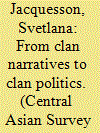

|
|
|
|
|
| Publication |
2012.
|
| Summary/Abstract |
This essay focuses on clan narratives as cultural tools in a particular sociocultural setting where mass literacy meets mass media. It shows how the interactions between different producers of clan narratives - the news media, the academic establishment and an intellectualist movement for the recovery of Kyrgyz history and culture - have resulted in a profound reshaping of the content of clan genealogies, of the claims of their compilers and, more significantly, of the ways various social actors relate to clan identities. Based on these analyses, it is argued that social representations and social practices related to genealogy and clans have undergone significant changes over the last 15 years, and that the production and consumption of clan narratives have played a crucial role in this transformation.
|
|
|
|
|
|
|
|
|
|
|
|
|
|
|
|
| 6 |
ID:
115815
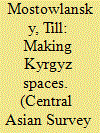

|
|
|
|
|
| Publication |
2012.
|
| Summary/Abstract |
In the past decade local scholars in Murghab, Tajikistan's easternmost district, have published several books in Kyrgyz on the history and culture of the Eastern Pamirs. In their work, the authors address the region's predominantly Kyrgyz population by emphasizing the 'kyrgyzness' of the Eastern Pamirs, which they refer to as Sarykol. The results of these local studies reverberate widely on the ground and have become integrated into everyday interaction. As a consequence, not only the region's history and culture, but also its territory, are perceived through an increasingly ethnicized lens. This paper seeks to explore local history as a way of appropriating space. Following Henri Lefebvre (1974), local history can be defined as an ethno-spatial practice that emphasizes ethnicity. Through an analysis of five works on local history and culture and their embedding in an ethnographic context, this article provides evidence for the significance of local studies in 'kyrgyzizing' space. It also demonstrates, moreover, that international non-governmental organizations, through their funding of such research, are entangled with globalized visions of culture, tradition and ethnicity.
|
|
|
|
|
|
|
|
|
|
|
|
|
|
|
|
| 7 |
ID:
115820
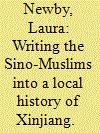

|
|
|
|
|
| Publication |
2012.
|
| Summary/Abstract |
The objective of this article is to look beneath the regional history of Xinjiang itself and examine the way in which, from the late Qing to the contemporary era, the state has recorded (and arguably failed to record) the local history of Sino-Muslim communities in Xinjiang. It will focus on the shifting relationship that the state has had with both the Sino-Muslims and the region itself, but also the political trends that have so constrained the telling of a local history that encompasses their experiences. At issue here is not whether the Sino-Muslims should be regarded as a distinct nationality or ethnic group, nor their claim to be 'local' (bendi ren), but rather the way in which this particular community, or indeed communities, have been reflected and recorded in the state's evolving narrative of the history of modern Xinjiang.
|
|
|
|
|
|
|
|
|
|
|
|
|
|
|
|
|
|
|
|
|